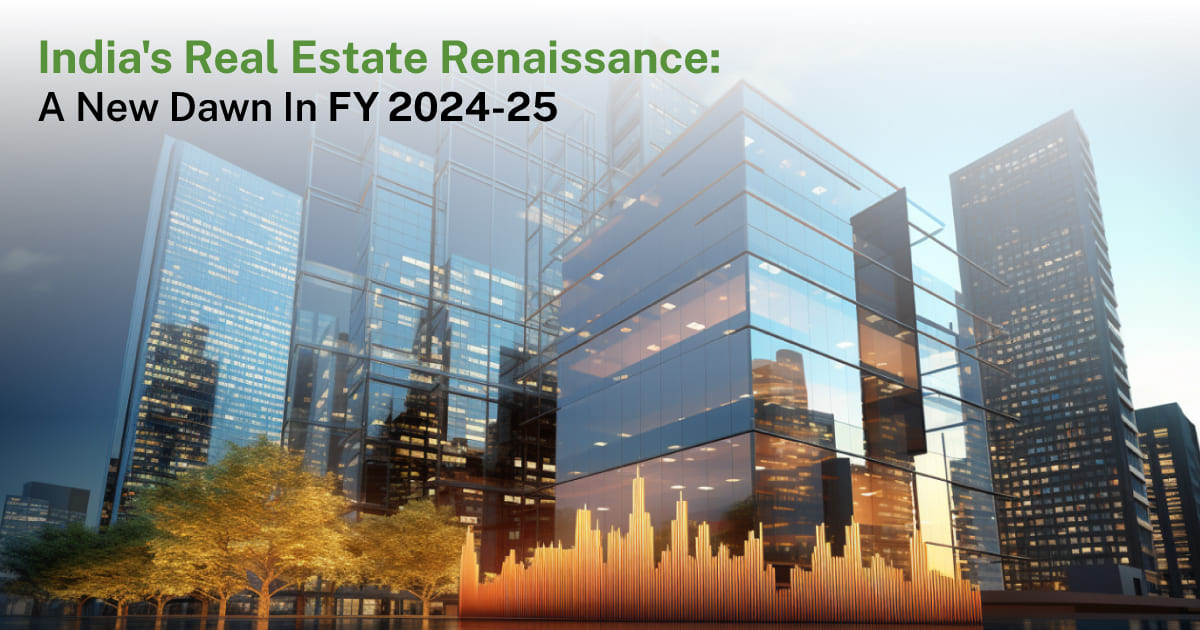
India’s Real Estate Renaissance: A New Dawn in FY 2024-25
India’s real estate sector is on the brink of a transformative era, heralding a renaissance that promises to redefine the landscape of urban living and commercial spaces. As we look towards FY2024-25, the confluence of economic growth, technological advancements, and proactive government policies is setting the stage for an unprecedented boom in both residential and commercial real estate markets. Let’s delve into the dynamics propelling this renaissance and explore the multifaceted growth anticipated in the coming fiscal year.
The Residential Revival
The Indian real estate sector, a critical pillar of the economy, is witnessing a significant revival, buoyed by robust demand and favourable policy measures. The anticipated surge in urban housing demand, aligned with the nation’s rapid urbanisation, is a key driver of this resurgence. With projections indicating a commendable 7-8% economic expansion, the residential market is set to flourish, propelled by:
Increased Accessibility to Home Loans: The gradual easing of interest rates by the Reserve Bank of India is making home loans more accessible, encouraging a surge in residential property investments.
Government-Backed Initiatives: Initiatives for affordable housing and infrastructure development are further fuelling the growth, with residential sales expected to escalate by 10-12%.
Technological Integration: The adoption of digital technologies is enhancing customer experiences and operational efficiencies, making the sector more appealing to a tech-savvy generation.
The Commercial Real Estate Boom: The commercial real estate (CRE) sector in India is poised for a historic best, with an expected growth rate of 7-8% in 2024. This optimism is grounded in several key factors that are contributing to the sector’s dynamism:
Rising Demand for Office Spaces: As businesses resume normal operations and expand, the demand for office spaces, particularly in the IT and ITeS sectors, is witnessing a significant uptick.
Growth of Real Estate Investment Trusts (REITs): REITs are anticipated to play a pivotal role, providing institutional investors with a transparent and lucrative avenue to invest in real estate assets. The projected growth of REITs is set to deepen liquidity and transparency in the sector.
Technological Advancements: The CRE sector is embracing digital transformation, utilising technology to enhance building operations, energy management, and tenant experiences.
This includes: Smart building technologies for enhanced operational efficiency
Green building practices for sustainability
Advanced security systems, including CCTV, for tenant safety
Government Initiatives and Policies: Supportive government policies and initiatives are bolstering the CRE sector. This includes infrastructure development projects and urbanisation efforts that are increasing the demand for commercial spaces.
Global Investment Flows: The CRE market is attracting significant interest from global investors, drawn by India’s economic growth and the sector’s high yield potential.
Unprecedented Growth and Change – A joint study by the PHD Chamber of Commerce and Industry and Grant Thornton Bharat highlights the potential growth statistics of the real estate sector, projecting an increase to 18% by 2030 from the current level of 7-8%. This growth is attributed to several emerging key segments, including co-working spaces, student housing, co-living/shared housing, data centres, senior assisted living, and warehousing.
Furthermore, rapid urbanisation and the government’s focus on infrastructure development are laying the groundwork for sustained growth in the real estate sector. Key government initiatives such as the Smart City Mission and the Pradhan Mantri Awas Yojana (PMAY) are pivotal in driving this growth, aiming to provide affordable housing and improve urban infrastructure. This, in turn, is expected to catalyse demand across both residential and commercial real estate segments.
Green Real Estate: The Future – Sustainability is becoming a cornerstone of India’s real estate development, with an increasing number of green-certified buildings. The sector’s shift towards eco-friendly practices is not only a response to environmental concerns but also a reflection of the growing demand for healthier and more sustainable living and working spaces. This trend is expected to accelerate, with the green real estate portfolio projected to grow significantly by 2025-2030.
Conclusion : As we look towards FY2024-25, India’s real estate sector stands at the cusp of a renaissance, driven by economic growth, technological innovation, and supportive government policies. The residential market is set to thrive on the back of increased affordability and demand, while the commercial sector is gearing up for unprecedented growth, fuelled by the expansion of businesses and the rise of REITs. With sustainability and digital transformation at its core, the future of India’s real estate looks brighter than ever, promising a new era of prosperity and development.



